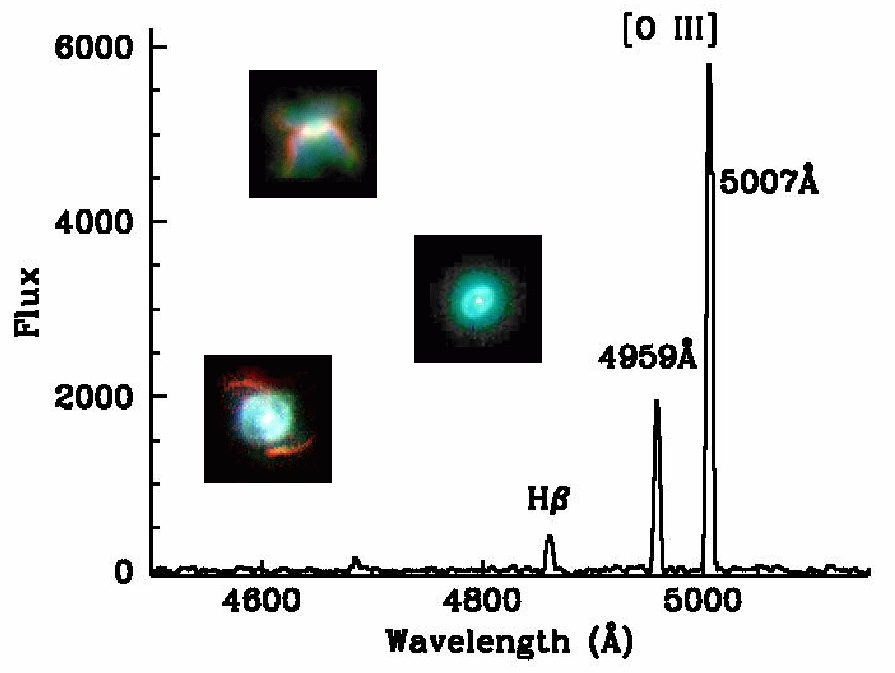Planetary Nebulae beyond the Milky Way
An ESO Workshop
| VLT image of centre of NGC5128 Rollover: Yellow: Stellar continuum image Green: [OIII] emission line image revealing PN |
 |
 |
 |
NGC 3379 with the PN.Spectrograph |
In the last decade the study of extra-galactic planetary nebulae (PN) has opened up in new ways. Planetary nebulae can be detected out to quite large distances from their strong emission lines, principally of [O III]. Photometry of the [O III]5007A emission line showed that the luminosity function of the PN population in a galaxy has a characteristic shape, and could be used as a secondary distance indicator. The emission lines can also provide nebular abundances, which can be related to those of the progenitor star, allowing the use of PN as chemical probes of galaxies. The emission lines are also narrow, making PN ideal kinematic probes of a galaxy's gravitational potential. By modelling the kinematics of the planetary nebulae in a galaxy, the properties of dark-matter haloes can be investigated.
Since planetary nebulae arise in the common low-intermediate mass stars, they provide a representative tracer of the progenitor stars in a galaxy. The physical parameters of PN (luminosity, age, chemical composition) can provide information on galactic star formation history and chemical evolution. Recently planetary nebulae have been detected in intra-cluster regions of nearby galaxy clusters. These PN can provide a unique handle on the number and type of stars in regions that may harbour a substantial amount of mass and contain kinematic history of galaxy interactions.
Extra-galactic PN can serve as probes of nearby galaxies and thus provide wider access to properties of galaxies. Planetary nebulae have traditionally been regarded as bright objects; however in the Local Group, and beyond, they can be faint. Large telescopes thus open up the field of extra-galactic PN study. HST and Adaptive Optics can provide images of PN in the LMC and SMC, at resolutions previously expected for Milky Way PN. New instrumentation is also being exploited to measure PN spectra in bulk. The field of extra-galactic PN research is developing rapidly and a conference to review the progress so far and to chart new developments is now timely.
This will be the first full workshop dedicated to the subject of extra-galactic planetary nebulae.
The format of the meeting will consist of invited reviews and contributed talks in the key areas of extra-galactic PN research. Central topics will be (with confirmed invited speakers):
- Historical overview (M. Barlow)
- Surveys for extra-galactic PN (R. Corradi, R. Mendez, J. Feldmeier)
- The PN luminosity function (R. Ciardullo)
- PN in the Magellanic Clouds (G. Jacoby, L. Stanghellini, E. Villaver)
- Observational dynamics of PN in galaxies (N. Douglas, E. Peng)
- Modelling dark matter with PN dynamical data (O. Gerhard)
- Status of abundance determinations in PN (X.-W. Liu)
- PN evolution and Asymptotic Giant Branch stars in galaxies (L. Willson, M. Groenewegen)
- PN as probes of chemical evolution and star formation history (M. Richer)
- Observations of PN in intra-cluster environment of galaxy clusters (M. Arnaboldi)
- Discussion sessions on observational challenges (coordinator Q. Parker) and
future directions for extra-galactic PN research (coordinator R. Shaw) - Workshop Summary (H. Ford)
Poster presentations are also anticipated and there will be scheduled discussion sessions. The proceedings will be published by Springer in the ESO Astrophysics Symposia series.
Scientific Organising Committee: M. Arnaboldi, R. Ciardullo, N. Douglas, K. Freeman, G. Jacoby, R. Mendez, R. Shaw, L. Stanghellini (co-Chair), G. Stasinska, J. Walsh (co-Chair)
Local Organising Committee: P. Bristow, N. Delmotte, M. Rejkuba, C. Stoffer, J. R. Walsh
Final registration deadline: 15 April 2004
| SOC & LOC | Registration | Accommodation Form | Programme |
|---|---|---|---|
| Important Deadlines | News & Announcements | Local Information | Proceedings |
